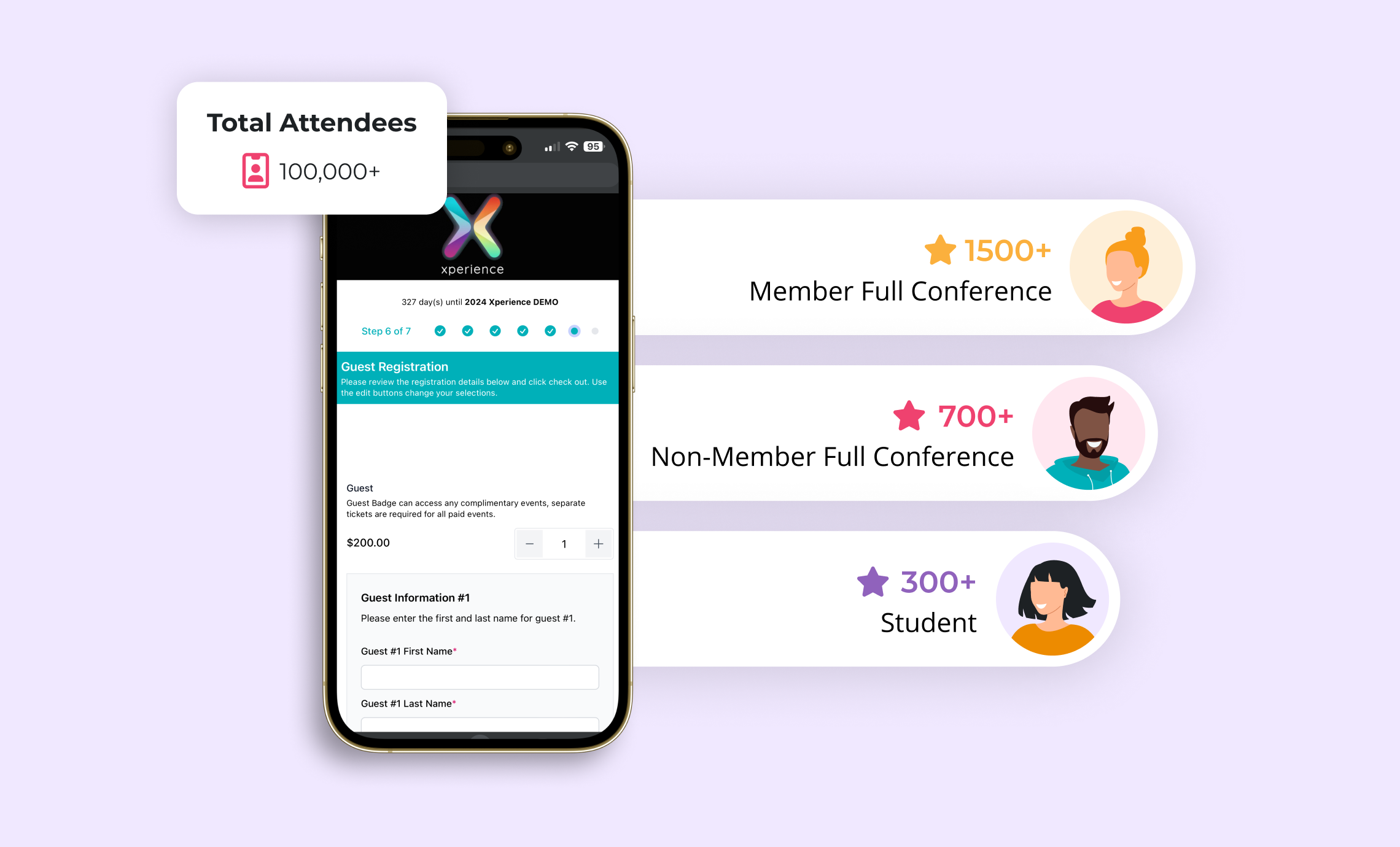Are you a business owner who wants to reach your intended audience or penetrate new markets? Or are you an events organizer struggling to generate traction for your trade shows? If so, this comprehensive guide for trade show displays is for you.
What is a trade show exactly? It’s an exhibition and promotional event where enterprises from a certain industry come together to unveil their newest lines of products. Like any marketing endeavor, these events need to be informative and engaging in yielding high traffic and conversion rates. Read on to learn how to set up a trade show booth or display effectively and efficiently.
Why is planning for a trade show important?
There are several reasons why business owners and event organizers need to thoroughly plan out a trade show event.
Reason #1: Organization is key.
A trade show is a major marketing endeavor that targets a specific industry’s ideal clientele. Every aspect of a successful trade show must be planned out in careful detail, whether it is the placement of the demo products, staff stations, or the easy availability of marketing materials like brochures and flyers. Without thoughtful organization, your product might receive negative reception, and you may lose a significant market percentage to competitors.
Reason #2: Sourcing the right equipment will give you an edge.
Trade show exhibits use several pieces of equipment, so you need to plan out exactly what fixtures and systems you’ll be utilizing. Consider questions like:
- What lighting system will best highlight your product?
- Will you be using an audio system, too?
- What are the measurements and design of the custom fixtures you’ll need?
- How many fixtures should you order?
Planning and deciding on these matters early on will help you source equipment from reputable suppliers and avoid the pitfalls of procrastination, like struggling with the wrong equipment the day of the show.
Reason #3: Ensure adequate staffing.
No matter how attractive your trade show displays are, it won’t matter if there’s nobody to man them. Not only should you hire qualified personnel to manage the booths but you should also plan out contingencies and look for backups in case some of them can’t arrive on the day of the show.
Trade show display made easy
If you’re new to the event-organizing industry, here are a few tips on how to make the trade show setup and execution processes easier.
Maximize available resources
Not all companies can allocate huge resources for trade shows. Instead of waiting for an unlikely budget increase, it’s sometimes better to maximize what you have on hand. Show creativity by building the fixtures from available raw materials. You can also stretch your funding by contacting different equipment suppliers and looking for promos and discounts.
Streamline the setup process
To make the setup process more manageable for you and your team, assign each person to a workstation. There should be people in charge of assembling and running the display, while others should be assigned to operate the light, sound, and visual systems.
Meanwhile, you or the designated supervisor should concentrate on overseeing the entire process and making sure that everything is in order.
Showcase a visually appealing and engaging display
Trade show booth design impacts audience engagement. After all, it’s your booth that visitors first see and interact with prior to the actual products. To ensure that your display is visually appealing, seek advice from a professional layout artist. Try hosting small yet interactive activities to attract your audience. Most importantly, always make sure that the display layout matches the company’s image or branding.
How to successfully set up a trade show
Setting up trade show exhibits is no easy feat. Use the following steps as a guide to successfully launch your next trade show.
Plan out the event
First, you need a logistics plan in order to figure out the types and amount of equipment you’ll need. Moreover, you need to know where to source them and how to transport them.
Create your marketing collateral
Determine the kinds of promotional materials you’ll need and the platforms you’ll use as distribution channels as part of your trade show marketing plan. Create a floor layout that promotes order and audience engagement. If you need help formulating and executing these plans, an event technology solutions provider like Expo Logic can give you a hand.
Find the perfect venue and staff
Find a place that fits the scale of the trade show you’ll host. To do this, identify how many people are projected to attend the event. Clarify how many exhibitors will be participating. Then, gather your crew. To ensure that all areas are covered, your staff should consist of crowd gatherers, lead gatherers, hosts, and presenters.
Look for sponsors
Sponsors are the lifeblood of any trade show. These companies not only fund events, but they also draw people in by launching their own advertising campaigns. Find as many sponsors as you can. To secure a deal, you must pitch your trade show ideas in a clear and precise manner. Pro-tip: bring your events portfolio to establish credibility and reliability.
Defining your trade show goals
Clear goals are central to the success of your trade show. In order to establish them, you should craft answers to the following questions:
- Why exactly are you launching a trade show event?
- Is it to establish brand awareness for new companies?
- Is it to market a new or lesser-known line of products?
Your SMART goals should always be detailed, actionable, realistic, and measurable. Otherwise, you’ll end up disappointing the trade show set-up companies that sponsor your event or overworking your staff to attain an unreachable objective.
By defining your event goals, you’ll be able to employ the right marketing strategies, avoid being sidetracked, and stay the course to success.
Creating a budget and timeline
Money and time are the most important resources of an event organizer because both are limited and must be used wisely.
Proper budget allocation
On average, companies spend over 31% of their marketing budget on trade shows. While the actual funding will depend on the financial standing of the sponsors, there are areas that always require budget prioritization. These are the booth space rent cost, exhibition stand construction and installation costs, logistics expenses, and staff wages. Allocate funding for these expenses first to prevent major budget issues later on.
Follow a timeline
The trade show process must follow a strict timeline. From the initial inspection of the prospective venue to the printing of the trade show banners, everything must be accomplished within the set deadline. Doing this will help prevent delays and give you time to make adjustments should complications or issues arise.
On-site logistics and staffing
Trade shows are public events that draw people from different parts of the country. To make sure that both the attendee’s convenience and safety are not compromised, certain logistical and staffing considerations need to be made.
Security
Protect everyone involved with your event by embracing professional safety measures. Sensors, cameras, and other modern security technologies should be placed in strategic areas of the venue. Attendance should be recorded, and all sessions should be properly managed by proven event logistics solutions.
Emergency procedures
Expo Logic can also help you develop floor plans that can be distributed to attendees. These plans have legends that inform attendees of not only where each exhibitor is but also where emergency exits are located. Count on our platform to deliver essential information and protocols regarding emergency procedures to the attendees.
Staffing requirements
The amount of personnel you need depends on the size of the trade show. However, all personnel should be vetted and have adequate knowledge about the event to properly assist the attendees and exhibitors.
Sourcing equipment and supplies for trade show display
Displays for trade shows have varying equipment and material requirements. Prior to sourcing trade show supplies, you should first ask the exhibitors for exact specifications. Then, contact your trusted supplier to deliver the systems, fixtures, and other required items.
To make sure that everything is set up properly, you can request that the supplier send an installation team as well.
Factors to consider when choosing the right venue
There are a few factors that need to be considered when selecting a venue for trade show exhibits.
Location
Always considers where your prospective audience is coming from when choosing an event location. If your attendees are traveling a considerable distance, scout a location that offers plenty of lodging options. The venue should also be in an area that is considered safe and welcoming.
Accessibility
Accessibility is also important. Make sure that there are adequate parking spaces in your chosen venue. If there are none, look for alternative secure parking lots nearby. The venue must be accessible to guests with disabilities, complete with wheelchair ramps, braille signage, and other building ADA-mandated accommodations.
Capacity
Whether or not you’ll need a large venue will depend on the number of exhibitors and attendees. Nevertheless, the venue you choose should be able to host at least 10% to 20% more participants than projected. This will give you more wiggle room and prevent overcrowding should more people decide to visit the trade show exhibits.
Marketing and promotion strategies
Coming up with effective marketing and promotion strategies is an essential part of trade show planning and management.
Social Media
Almost 5.5 billion people use social media platforms like Facebook, Twitter, TikTok, and Instagram, which means these platforms should be integral to your trade show marketing strategy. Post advertisement posters, videos, and other content on your social media channels. You can also invest in paid ads to reach a wider audience or partner with social media influencers and ask them to promote your trade show.
Email marketing
Around 69% of advertising professionals uses email marketing as a means to distribute their promotional materials and content. This is not surprising since sending an email is more personal and direct than posting content on public channels.
Be concise yet precise when sending emails about your trade show to your prospective attendees and sponsors. Moreover, answer their queries as soon as possible. If you don’t have enough manpower, invest in AI tools like chatbots that can autonomously engage with your audience and provide timely responses to their questions or concerns.
Conventional advertising
While digital marketing has become the more popular approach, you should still allocate some resources to traditional advertising mediums. This will help you widen the breadth of your campaign and reach people who are less tech-savvy. Print and distribute trade show banners, brochures, flyers, and other physical marketing materials. If you have the means, you could also promote your trade show on a billboard.
Designing an engaging and effective booth
Here are a couple of trade show booth ideas that can make your displays more engaging and appealing.
Use an interactive layout
Interactive elements are an important driver of engagement at a trade show booth. Consider setting up a large touchscreen display that visitors can use to learn more about your products and services. Mechanical apparatuses or robots that continuously and autonomously provide item demos also provide an entertaining and informative appeal to your booth
Demonstrate brand consistency
Ensure that the booth design is consistent with the exhibitor’s brand. All designs for trade shows must incorporate the company logo. Moreover, their color scheme should match that of the company. If the exhibitor has a mascot, include that in the trade booth design as well. Doing this will help boost brand awareness and product association.
Allocate an area for negative space
While you’re free to add creative elements to your trade show booth, ensure that there’s still adequate area for negative space. Negative space gives your audience breathing room and balances the composition of your display. Always avoid cluttering your booth with too much furniture, bulky items, and nonessential design components.
Attracting and managing vendors and attendees
If you want to attract vendors and attendees to your trade show, you must make your booth stand out.
Host engaging events
Attendees like exhibits that host games, raffles, and interactive shows. Ideally, your booth should accommodate engaging opportunities and activities that also promote the company brand and product either directly or implicitly.
Give freebies
Around 52% of trade show visitors are more likely to pay attention to an exhibit that offers a freebie or giveaway. As a benefit to you, choose freebies that bear your name and logo as marketing materials that facilitate brand recognition. Distributing simple yet relevant items should entice more attendees to visit your trade show while making it memorable.
Orient your staff
To attract not only attendees but also potential vendors, you must have competent personnel. They should have ample knowledge about your products and services and be able to recite your product and sales pitches with pitch-perfect confidence. Knowing the ins and outs of the trade show will help your staff properly guide visitors and answer their questions on the day of the event.
Conducting follow-up and lead generation after the trade show
Trade show management doesn’t end after the event. To get good conversion rates, you should conduct post-event communication and strategic follow-ups.
Classify and qualify leads
First, group your leads according to their degree of participation and interest. You can assign a group for those who merely inquired about the product and another group for those who requested a demo.
Then, qualify your leads either as cold or hot. Cold leads are those who show interest but are not ready to make a purchase yet. Meanwhile, a hot lead is already ripe for a transaction. If you want accurate data and metrics on onsite leads, the trade show-tested teamExpo Logic can help.
Utilize the correct sales strategies
To generate more leads and turn existing ones into sales, you should utilize effective post-trade show marketing strategies. You can send follow-up emails to cold leads and either re-introduce, remind, or re-engage them with your products and services. Meanwhile, let your most experienced sales agents handle the hot leads.
Measure your success by evaluating your trade show ROI
Aside from knowing how to set up a trade show, you should also learn to measure and analyze your event’s success.
How to measure your trade show’s ROI
There’s a simple formula to measure your trade show ROI. It requires you to get the difference between your revenue and investment and then divide the result by the cost of investment.
For instance, if the income you generated from the event is $100,000 and the investment you put in was $50,000, then you’ll get a value of 1. This translates to a 100% ROI.
How to analyze your trade show’s success
You can analyze your trade show’s success by assessing if your ROI matches your initial profit projection. Moreover, you can use the lead metrics and data collected by Expo Logic’s intuitive software solution to determine where you excel against the areas that need improvement.
Wrapping up your trade show
Once the trade show is over, you’ll have to swiftly and efficiently pack up. This is especially true if there are other event organizers who will be using the same venue.
Dismantle the display
After the event, you’ll have to dismantle the trade show exhibits and displays. Just like in the setup process, delegate tasks to each staff member. Moreover, avoid damaging the venue’s flooring or other structures in the process. If you and your team are not familiar with how to disassemble the displays, call in professional technicians.
Gather leftover supplies
Don’t throw away leftover supplies and materials. They can still be used in future trade show projects. Carefully gather them and assign one of your staff to make an inventory. Pro-tip: label everything so that you don’t have problems identifying and locating a specific supply the next time you need it.
Debrief your team
To make sure that everything has been accounted for, you need to debrief your team. Ask them if all the booths and materials have been packed up. Requesteports about critical aspects of the event, such as attendee satisfaction and operational issues. Lastly, thank them for the job well done, and call it a day!


